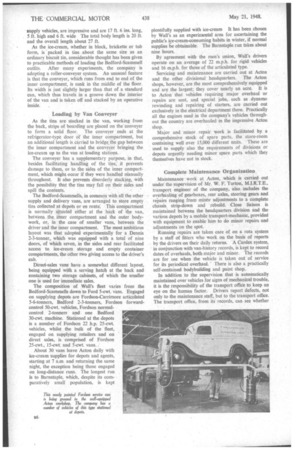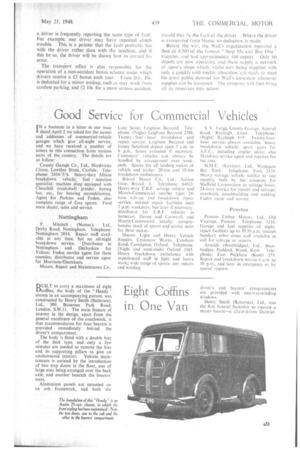T WENTY-FIVE years ago a young man returned from a trip
Page 38

Page 40

Page 43

If you've noticed an error in this article please click here to report it so we can fix it.
to America with an idea for selling ice-cream. He suggested to his company that a fleet of tricycles be employed to market what was not, at that time, a saleable commodity in England. This year the same man, Mr. Cecil W. Rodd, who is now the chairman of T. Wall and Sons, Ltd., announced that his concern was the • first to install radio sets on commercial vehicles for the benefit of
drivers. "
There may seem little connection between these .two developments, but. they are, in fact, part and parcel of the same idea,,-that if you have an unusual commodity to sell on a nation-Wide basis, transport arrangements, must.:, have first consideration. Ice-cream is probably one of the most perishable of all commodities, and it will melt if not kept under 'proper' conditions. Yet this well known concern supplies the whole Of England. and as far as Edinburgh, with ice-crearn Produced at only two plants-:—Acton, in London, and Godley, in Manchester. This service will shortly be augniented by a third plant to be opened at Craigmillar; Edinburgh. To ensure that ice-cream is delivered in good condition to the -provincial depot, the shop or the home, speedy and adequate transport facilities are of vital importance. This problem has been met first, by the construction of special van bodies in which the latest developments in the fields of insulation and handling have been incorporated and, secondly, by paying the closest attention to servicing and maintenance and the human factors involved in the operation of a transport section.
The fleet to-day is comprised of about 500 vehicles. of which some are engaged in deliveries of sausages and meat pies. Of Shis total, about 200 are stationed at the headquarters division at Acton, and the remainder is split up between the five other divisions at Godley, Birmingham, Southampton, Croydon and Craigmillar. Edinburgh. From Acton and Godley, ice-cream is -sent
na
in bulk to about 60 depots throughout the country, from which it is supplied to retailers or direct to the consumer.
The supply fleet consists mainly. of Bedford 3-4tormers' and Bedford-Scammell articulated 7-8.tonners. These vans make deliveries several times a week to Southampton, Bristol, Barnstaple, Birmingham, Clacton, Norwich, Brighton and Lowestoft. The bodywork for both types is built entirely at the Acton works by Wall's, which, since the war, has constructed bodies for the majority of its supply and direct-sale vans, .embodying the results of the company's experience in the. transport and handling of ice-cream. The capacity of the Bedford-Scammell machines is 2,000 gallons of icecream.
Constructional principles are the same for all Wall's vans, which are insulated, rather than refrigerated. The bodywork consists of an inner insulating.chamber,
with sheetsof Onozotea..-.fOrm of expanded rubber—for the sides and too, and a' 3-in, sheet at the bottom of the chamber. The Onozote is surrounded on the outside by plywood,. anclfonJhe inner side, for durability, by matchboarding. On the larger vehicles an air gap of as much as 5 ins, is left between the inner body and the outside covering. Ventilation is provided
for by airholes in the roof. • • .
The interiors of the Bedford-Scarnmells, the largest supply vehicles, are impressive and are 17 ft. 6 ins. long, 5 ft. high and 6 ft. wide The total body length is 20 ft. and the overall length about 27 it.
As the ice-cream, whether in block, brickette or tub form, is 'packed in tins about the same size as an ordinary biscuit tin, considerable thought has been given to practicable methods of loading the Bedford-Seammell outfits. After many experiments, the company is adopting a roller-conveyer system. An unusual feature is that the conveyer, which runs from end to end of the inner compartment, is sunk in the middle of the floor. Its width is just slightly larger than that of a standard can, which thus travels in a groove down the interior of the van and is taken off and stacked by an operative inside. . Loading by Van Conveyer As the tins are stacked in the van, working from the back, strips of boarding are placed on the conveyer to form a solid floor. The conveyer ends at the refrigerator-type door Of the inner compartment, but an additional length is carried to bridge, the gap between the inner compartment and the conveyer bringing the ice-cream up to the van at loading stations.
The conveyer has a supplementary purpose, in that, besides facilitating handling of the tins, it prevents damage to them, or to the sides of the inner compartment, which might occur if they were handled Manually throughout. It also prevents disorderly stacking, with the possibility that the tins may fall on their sides and spill the contents.
The Bedford-Scammells, in common with all the other supply and delivery vans, are arranged to store empty tins collected at depots or en mine: This compartment is normally situated either at the back of the van, between the inner compartment and the outer bodywork, or, in the case of smaller vans, between the driverand the inner compartment. The most ambitious layout was that adopted experimentally for a Dennis 2-3-tonner, which was equipped with a total of nine doors, of which seven, in the sides and rear facilitated access to ice-cream storage and empty container compartments, the other two giving access to the driver's cab.
Direct-sales vans have a somewhat different layout, being equipped with a serving hatch at the back and containing two storage cabinets, of which the smaller one is used for immediate sales.
The composition of Wall's fleet varies from the Bedford-Scammells down to Ford 5-cwt. vans. Engaged on supplying depots are Fordson-Carrimore articulated 5-6-tonners, Bedford 2-3-tonners, Fordson forwardcontrol 50-cwt. vehicles, Fordson normalcontrol 2-tonners and one Bedford 30-cwt. machine. Stationed at the depots is a number of Fordson 22 h.p. 25-cwt. vehicles, whilst the bulk of the fleet, engaged on supplying retailers and on direct sales, is comprised of Fordson 25-cwt., 15-cwt. and 5-cwt. vans..
About 30 vans leave Acton daily with ice-cream supplies for depots and agents, starting at 7 a.m and returning the same night, the exception being those engaged on long-distance runs. The longest run is to Barnstaple, which, despite its comparatively small population, is kept plentifully supplied with ice-cream It has been chosen by Wall's as an experimental area for ascertaining the public's ice-cream-consuming habits in winter, if normal supplies be obtainable. The Barnstaple run takes about nine hours.
By agreement with the men's union, Wall's drivers operate on an average of 22 mph. for rigid vehicles and 16 mph. for those of the articulated type.
Servicing and maintenance are carried out at Acton and the other divisional headquarters. The Acton shops, however, are the most comprehensively equipped and are the largest; they cover nearly an acre. It is to Acton that vehicles requiring major overhaul or repairs are sent, and special jobs, such as dynamo rewinding and repairing of starters, are carried out exclusively in the electrical department there. Practically all the engines used in the company's vehicles throughout the country are overhauled in the impressive Acton shop.
Major and minor repair work is facilitated by a comprehensive stock of spare parts, the store-room containing well over 15,000 different units. These are used to supply also the requirements of divisions or depots urgently needing minor spare parts which they themselves have not in stock.
Complete Maintenance Organization Maintenance work at Acton, which is carried out under the supervision of Mr. W. F. Turton, M.I.R.T.E., transport engineer of the company, also includes the overhauling of gearboxes, rear axles, steering gears and re-pairs ranging from minbr adjustments to a complete chassis strip-down and rebuild. Close liaison is maintained between the headquarters division and the various depots by a mobile transport-mechanic, provided with equipment tO enable him to do minor repairs and adjustments on the spot. Running repairs are taken care of on a rota system by a staff of fitters who work on the basis of reports by the drivers on their daily returns. A Cardex system, in conjunction with van-history records, is kept to record dates of overhauls, both major and minor. The records are for use when the vehicle is taken out of service for its periodical overhaul. ' There is also a practically self-contained bodybuilding and paint shop.
In addition to the supervision that is automatically maintained over vehicles for signs of mechanical trouble, it is the responsibility of the transport office to keep an eye on the human factor. Drivers report defects, not only to the maintenance staff, but to the transport office. The transport office, from its records, can see whether a driver is frequently reporting the same type of fault For example, one driver may have repeated clutch trouble. This Is a pointer that the fault probably lies with the driver rather. than with the machine, and if this be so, the driver will be shown how to correct his error.
• The transport office is also responsible for the operation of g non-accident bonus scheme under which drivers receive a-5 bonus each year. From this, 10s. is deducted for a minor mishap, such as may result from careless parking, and -42 10S. for a more serious accident. .should they be the fault of he driver. Where the driver is exonerated from blame, no deduction is made.
Before the war, the Wall's organization operated a fleet of 8,500 of the famous "Stop Me and Buy One."
tricycles, and had approximately 160 depots Only 60 depots arc now operating. and these supply a network of agent's shops which. whilst now being supplied with only a quickly sold weekly allocation. are ready to meet the great public demand for Waifs ice-cream whenever supplies can be increased. The company will then brine, all its resources into action.












































































